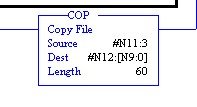RSLogix 5 - CPT dest. adress - help
- Thread starter ason
- Start date
Similar Topics
I am having problems with (invalid expression or tag)
I want to do the following:
Cut_Count[1].ACC
multiplied buy
Read_Data[0]
multiplied by
31.5...
This should be a simple one.
I'm trying to use a boolean value in a CPT instruction to either add a value or not. This is the statement...
I was pleasantly surprised to learn that the Micrologix 1400 has the Compute (CPT) instruction available. But my problem is this: The two...
Hi folks,
I'm back again with a new question to you....While testing a code I made, I've noticed something I can't explain. I'm using the CPT...
I am trying to interpret a compute function in RSLogix 500. This seems like a stupid question but it has me stumped. Maybe someone can help.
The...





